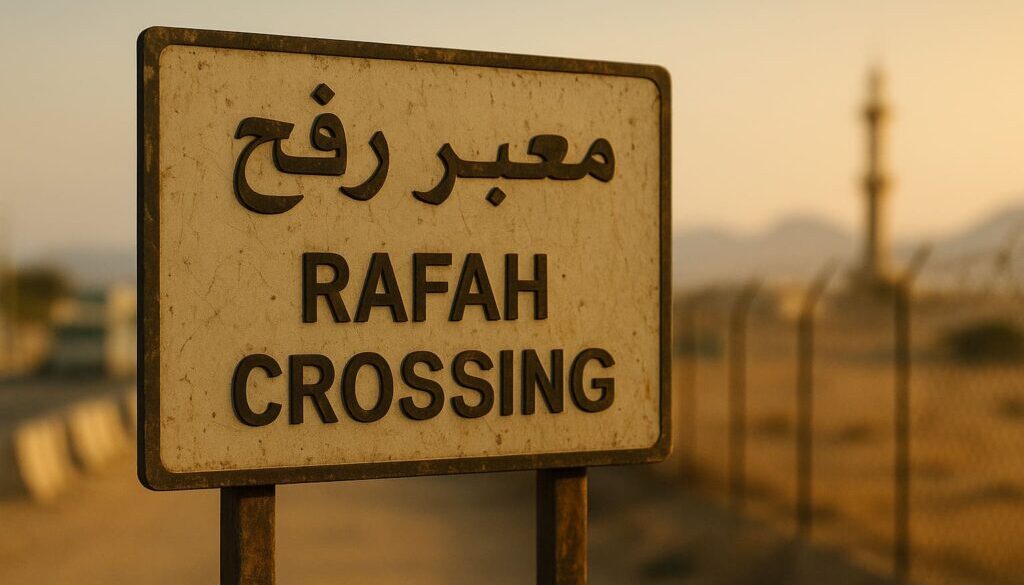Gaza Strip & Sinai gateway
Where is the Gaza–Sinai gateway?
Gaza’s setting: A sliver on the southeastern Mediterranean, wedged between Israel (north & east) and Egypt’s Sinai (southwest). It spans ~365 km² (≈ 140 sq mi); think a narrow coastal plain about 40–41 km long and ~6–12 km wide—one of the world’s densest territories.
Why this matters: In map-based questions, examiners love the tri-junction at Kerem Shalom (where the borders of Israel, Gaza, and Egypt meet) and the Rafah urban cluster straddling the frontier. Label these precisely.
How did this border take shape?
1906 delimitation (pre-WWI): A boundary from Taba to Rafah was fixed between Ottoman Palestine and British-ruled Egypt, passing through Rafah—the seed of today’s split city. For static history, that 1906 line is the key “origin point” of the modern Gaza–Egypt border.
1979 Egypt–Israel Peace Treaty: After 1967, Israel occupied Sinai and Gaza; the 1979 treaty returned Sinai to Egypt and instituted security zones (A, B, C, D) with demilitarization levels in Sinai and adjacent Israeli territory. This is the legal backbone for force limits in eastern Sinai’s Zone C, which abuts Gaza. For treaty-law answers, cite Article IV and Annex I arrangements, and the MFO (Multinational Force & Observers) which monitors compliance.
2005 disengagement & “movement” accords: Post-disengagement, two texts anchor the crossings regime in the static syllabus:
-
Agreement on Movement and Access (AMA, 2005): Aims to facilitate movement of people/goods, and envisaged safe passage, port/airport, and improved crossings.
-
Agreed Principles for Rafah Crossing (APRC, 2005): Structured Rafah’s operation with EU third-party monitoring (EU BAM Rafah).
These show how border governance is designed on paper—useful for treaty-to-practice contrasts.
Crossings architecture you must know
Rafah Crossing (Egypt–Gaza): The only land crossing between Gaza and Egypt, historically configured for people (pedestrian traffic) rather than commercial cargo. In conflict periods, it has intermittently channeled humanitarian flows, but its classical design/function remains passenger-oriented.
Kerem Shalom (Israel–Gaza, near tri-junction): Primary commercial gate for goods into Gaza for years, including consignments originating in Egypt that are routed via Israeli control/inspection regimes before entry. For static logistics, assume: Kerem Shalom = cargo, Rafah = people, with notable wartime exceptions.
Erez (Beit Hanoun, Israel–Gaza): Historically the main people-movement gate with Israel (permits/categories apply), useful as a map label though often shut during hostilities. (Know it for pre-2023 mobility context).
Salah al-Din Gate (adjacent to Rafah, Gaza side): Since 2018, a secondary commercial interface from Egypt, expanding material inflows (construction materials, selected goods) under local control—an exam-worthy nuance showing how de facto trade channels evolve.
The Philadelphi Corridor (Salah al-Din axis): geography, status, significance
What it is: A ~100 m-wide, ~14 km-long strip running the entire Gaza–Egypt land border, from the Mediterranean to Kerem Shalom. On any labeled sketch, draw this as the border-hugging security belt.
Why it matters: Under the 1979 arrangements and subsequent understandings (including the 2005 “Philadelphi” deployment understanding allowing limited Egyptian Border Guard forces), the corridor is central to smuggling control, buffer-zone enforcement, and lately—during the 2024–25 hostilities—became a flashpoint when Israel asserted control along the strip, raising Egypt–Israel friction and altering humanitarian routing. This is a classic “security law meets geography” vignette.
Population density: the static fact that drives risk and policy
With ~2.23 million people in ~365 km², Gaza’s implied density is well over 6,000 persons/km²—and even higher in the northern urban belt (Gaza City and environs). For demographic framing in answers (urbanization, civilian risk, logistics per capita), anchor to Britannica’s area/population figures.
(Note for your sheet: density is a derived number—quote the sourced area and population, then do a quick back-of-the-envelope for the examiner.)
Humanitarian access “corridors”: concept vs. field reality
Concept (IHL & practice): A humanitarian corridor is not a term in treaty law with a single binding definition. In practice, it means time- and route-bound arrangements to let aid and civilians move safely through active hostilities—requiring consent/assurances from parties, notification/deconfliction, predictable inspection regimes, and security guarantees. Use this static framing in ethics/IHL answers.
Notification/Deconfliction: The UN-run Humanitarian Notification System (HNS) is a voluntary arrangement where agencies share coordinates of facilities and movements so parties should avoid striking them. In Gaza, HNS and related deconfliction have frequently under-performed, with agencies and analysts documenting denials, disruptions, or non-use—an important limitations-of-corridors point to remember.
How aid actually moves via the Sinai gateway (Al-Arish → Gaza): the static logistics chain
Staging hub: Al-Arish (North Sinai) operates as the main humanitarian logistics hub—warehousing, convoy marshaling, and coordination led by the Egyptian Red Crescent (ERC) with UN agencies. For static notes, mark Al-Arish port/airport as the feeding point for Rafah/Kerem Shalom.
Inspection steps (typical configuration):
-
Screening near Rafah/Al-Arish on the Egyptian side;
-
Israeli security inspection—often at Nitzana/Al-Oja—where any single rejected item can trigger rejection or re-palletization of a whole consignment;
-
Entry into Gaza primarily via Kerem Shalom, not Rafah (especially when Rafah is shut or constrained). This three-step chain explains backlogs and oscillating truck counts.
Throughput (static perspective): OCHA’s “crossings” dashboards and monthly snapshots track volumes and denials; historically, Kerem Shalom carries the commercial/aid load, while Rafah varies with security/political conditions. For a dry-run data point in notes, cite OCHA’s crossings page (pre- and post-Oct 2023 trends).
(You need not memorize volatile daily truck numbers; stick to the process, nodes, and roles—that’s what UPSC values in static questions.)
Rafah vs. Kerem Shalom: the exam-worthy contrast
-
Rafah: Traditionally people-movement (passports, patients, students; episodic humanitarian convoys); operational continuity is politically sensitive because it embodies Egypt–Gaza connectivity without Israeli territory.
-
Kerem Shalom: Goods/commercial artery, even for consignments originating in Egypt that must pass Israeli inspection before entering Gaza—hence its centrality to any corridor plan.
This static division of labor is your safest exam line—then you can add the rider: wartime exceptions and closures have periodically flipped or constrained these roles.
The Sinai security envelope around Rafah: why Zone C matters
Zone C (eastern Sinai, along Israel/Gaza borders) is lightly militarized by treaty design; Egypt deploys Border Guard forces with limits on heavy assets, monitored by the MFO. Any large-scale military push, buffer-zone expansion, or foreign presence along the Rafah–Philadelphi strip triggers treaty-compliance and diplomatic questions. Knowing the zones map and what each permits is high-yield for GS-2.



